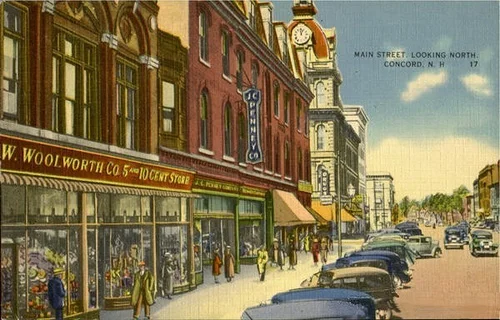Take a Walking Tour of Historic Downtown Concord, NH
The buildings and streets of downtown Concord, NH, are a community steeped in tradition, yet well-adapted to change. Concord’s European settlers laid out Main Street in 1726. Farmhouses on modest house lots, soon joined by a few small shops, lined the street; eld lots lay in the Merrimack River oodplain below. In 1803 the First New Hampshire Turnpike opened, linking Concord with Portsmouth cementing the town’s position as an important trading and transportation center. Scores of stagecoaches, wagons and animals traveled down Main Street daily, headed to Boston or Portsmouth.
See the full tour HERE
Concord’s central location within the state led to its designation as state capital in 1808 and secured the community’s role as the heart of political and social life in New Hampshire. After the State House was completed in 1819, the center of community activity began to shift from farther north to present- day downtown. In 1842 the railroad came to town, and Concord became the gateway to northern New England, ushering in a half-century of major growth and prosperity. By century’s end, the railroad, with dozens of passenger trains daily and immense repair yards, was the city’s largest employer.
With the arrival of the railroad, the appearance of downtown Concord began to change, quickened following a fire in 1851 that destroyed many of the buildings on the east side of Main Street. Wooden houses and shops gave way to three and four-story buildings of brick and granite. These new buildings housed not only stores, but hotels, theaters, meeting halls and apartment units. West of Main Street were some of New England’s finest churches, public buildings and residences. East of Main Street were factories, warehouses, stables and, running parallel to the Merrimack River, the railroad and its yards.
Throughout the 19th and early 20th century, Concord supported a tremendous variety of manufacturing enterprises, whose products were shipped worldwide and whose diversity sustained the community over the years – as one business or industry fell on hard times, another picked up the slack. Initially the river and early turnpikes provided the needed transportation for this successful manufacturing base; later it was the railroad. Musical instrument and sterling silverware production, furniture-making, printing, carriage manufacturing (led by the famed Abbot-Downing Company), harness and axle production, and granite quarrying numbered among the more proli c industries. In more recent years, state government and health care have been major employers. Since 1920 New Hampshire has hosted the country’s 1st Presidential Primary elections, shining a spotlight on the capital city every four years.
Main Street was one of the state’s principal highway routes until I-93 bypassed it in the mid-1950s. A few years later, a large shopping center emerged on the site of the railroad station. Feeling threatened by new trends in retail, Main Street owners responded by lopping of some upper stories to reduce building heights, covering facades with sleek metal panels and installing wide sign bands. There was even an effort to install a moving sidewalk to lure shoppers from the Stores Street shopping center up to Main Street. Federal funding programs and a shift in architectural tastes in the 1980s ushered in a new era of downtown rehabilitation, reviving the historic character of many buildings and leading to the listing of the entire downtown on the National Register of Historical Places. Today, something great is going on in Concord, NH. This state capital is becoming the cultural center of the Granite State. After a $14 million dollar renovation of Main Street the city has a host of new eateries, cultural venues and shops. Downtown also boasts a boutique movie theater, performing arts center, music school, art school and a public theater.
Concord is a small city with some big city offerings, with a variety of art-inspired stores, galleries and unique shops with great finds.

